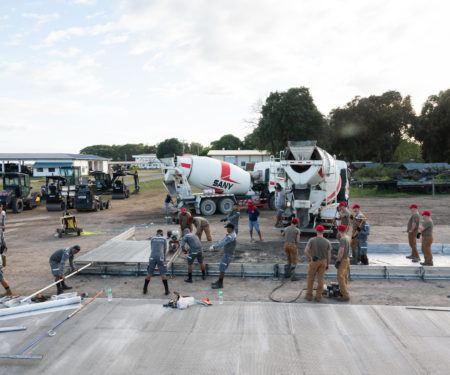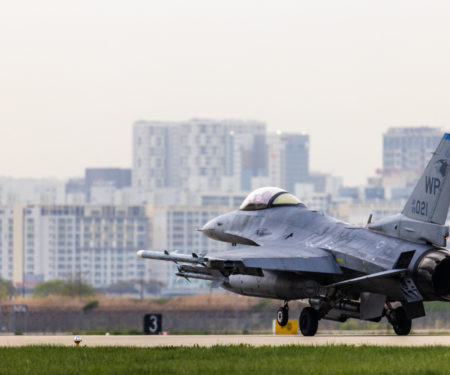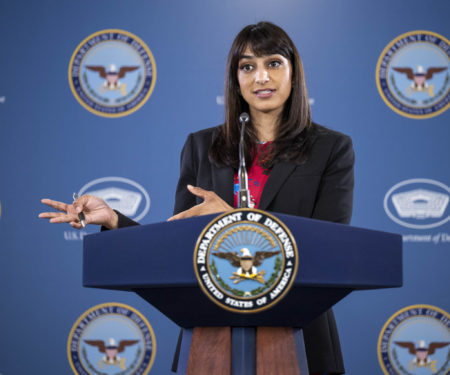Radar Sweep
Pay Troops At Least $15 Per Hour? A GOP Lawmaker Wants to Raise the Military’s Minimum Wage
A Republican lawmaker is renewing an effort to boost the salary of the lowest-paid service members. Service members would be entitled to a base pay rate of at least $31,200 per year, or the equivalent of $15 per hour for a 40-hour workweek, under the Raising Annual Income of Servicemembers by Enhancing, or RAISE, Minimum Base Pay Act reintroduced by Rep. Mike Garcia, R-Calif., late last week.
A ‘ChatGPT’ For Satellite Photos Already Exists
Scene: A U.S. adversary is at work on a new type of drone, ship, or aircraft and it’s your job to find it, wherever it is. Not long ago, that task would take a massive effort of human, signals, and open-source intelligence collection. But a researcher from AI company Synthetaic has created a tool that will allow users to find virtually any large object that exists in any satellite photo of the Earth within just one day. It’s also the sort of capability the National Geospatial-Intelligence Agency is also looking to develop, and it could radically shift strategic advantage on the battlefield.
New Developments in Warfighter Training
Driven by advancements in technology and research, the Air Force and Space Force are adapting how they train their warfighters to complete the missions at hand. Keep up with all the latest news on changes and improvements to the services’ training enterprises.
Joint Chiefs Shuffle: Biden’s Top Contenders to Replace Trump’s Military Leaders
Donald Trump handpicked the nation’s top military brass while he was in office. Now it’s Joe Biden’s turn. As many as five members of the Joint Chiefs of Staff, the eight most senior uniformed leaders who advise the president on military issues, are scheduled to leave their assignments this year. Besides the Joint Chiefs chair, the heads of the Army, Navy, Marine Corps, and potentially the Air Force are all set to leave. Three of the military’s top operational commanders are changing over as well: The heads of Northern Command, Space Command, and Cyber Command.
South Korea and Japan Resume Intel Sharing Agreement, But Not All Problems Are Solved
North Korea’s barrage of missile tests and China’s swelling military modernization appear to have driven two of Asia’s reluctant partners back into each other’s arms, with South Korea and Japan agreeing to restore the sharing of highly classified intelligence. South Korean President Yoon Suk Yeol and Japanese Prime Minister Fumio Kishida met during March 16 in Japan, and shortly thereafter South Korea announced it was resuming the use of the General Security of Military Information Agreement (GSOMIA).
Allies’ Plans for New AUKUS ‘Innovation Initiatives’ Unveiled in DOD’s 2024 Budget Request
The Office of the Secretary of Defense is requesting $25 million in fiscal 2024 for a new-start program to drive the development of underwater drones, artificial intelligence, and other emerging technologies for operations associated with an enhanced trilateral security partnership among Australia, the U.K., and the U.S.
OPINION: Don’t Want to Lose Ukraine? Empower Kyiv with Airpower
Ukraine has long pleaded for more airpower as it tries to push back Russian invaders, though Washington has been hesitant to take that step. In the op-ed below, Mitchell Institute for Aerospace Studies Executive Director Douglas Birkey says new information about the state of the battlefield shows it’s past time for the Biden administration to get onboard.
Keeping Watch on Aggressor Satellites a Key Challenge for US Space Force
he U.S. Space Force is facing a new challenge in its role to safeguard the country’s satellites from foreign threats, as Russian and Chinese satellites engage in disruptive maneuvers and follow other nations’ spacecraft in orbit. Military leaders have raised concerns about the “cat-and-mouse” games they claim are being played, which has resulted in confusion and potential security risks. To counter this, the Space Force is increasing funding for ground and space-based sensors to gain a better understanding of the situation in orbit.
GAO Wants Air Force, Navy Plans for Directed Energy Weapons to Transition the ‘Valley of Death’
Directed energy weapons continue to hold the interest of defense officials looking for capabilities like counter-drone and missile defense systems, but a new report claims that the Air Force and Navy have yet to implement plans needed to transition the technology through what’s known in acquisition circles as the “valley of death.” The Government Accountability Office report examined directed energy program transition plans for the Army, Navy, and Air Force, noting that latter two have either not documented transition agreements or, in some cases, identified transition partners to help them move from prototype to full acquisition programs.
What Air Force Combat Controllers Go Through to Earn Their Titles
According to the U.S. Air Force’s 24th Special Operations Wing, the mission of a combat controller is to, “deploy, undetected, into combat and hostile environments to establish assault zones or airfields, while simultaneously conducting air traffic control, fire support, command and control, direct action, counter-terrorism, foreign internal defense, humanitarian assistance, and special reconnaissance in the joint arena.” With such a broad mission, combat controllers must become certified and maintain proficiency in everything from FAA-certified traffic control, qualified combat diving, and free fall parachuting to certification as a joint terminal attack controller.



